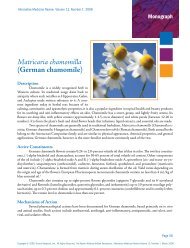Astaxanthin, Cell Membrane Nutrient with Diverse Clinical Benefits ...
Astaxanthin, Cell Membrane Nutrient with Diverse Clinical Benefits ...
Astaxanthin, Cell Membrane Nutrient with Diverse Clinical Benefits ...
Create successful ePaper yourself
Turn your PDF publications into a flip-book with our unique Google optimized e-Paper software.
amr<br />
in peer-reviewed journals and some were published<br />
only in Japanese. However, the English-language,<br />
peer-reviewed publications sufficiently establish<br />
astaxanthin as a nutrient <strong>with</strong> broad-ranging<br />
efficacy and safety.<br />
Biochemistry<br />
The Unique Molecular Layout of <strong>Astaxanthin</strong><br />
<strong>Astaxanthin</strong> (3,3’-dihydroxy-beta,beta-carotene-<br />
4,4’-dione) belongs to the xanthophyll subclass of<br />
carotenoids. It has oxygen in its molecular structure,<br />
which sets it apart from beta-carotene and<br />
other molecules of the carotene subclass. 5 The<br />
astaxanthin molecule has an extended shape, <strong>with</strong><br />
a polar structure at either end of the molecule and<br />
a nonpolar zone in the middle (Figure 1). The polar<br />
structures are ionone rings that have potent<br />
capacity for quenching free radicals or other<br />
oxidants, primarily in an aqueous environment,<br />
but possibly also in the absence of water. 8,9<br />
The nonpolar middle segment of the astaxanthin<br />
molecule is a series of carbon-carbon double bonds,<br />
which alternate <strong>with</strong> carbon-carbon single bonds<br />
– termed “conjugated.” This series of conjugated<br />
double bonds gives the molecule a further antioxidant<br />
dimension, <strong>with</strong> a capacity to remove highenergy<br />
electrons from free radicals and “delocalize”<br />
their electronic energy via the carbon-carbon chain<br />
– analogous to a lightning rod on the molecular<br />
level (Figure 2). 10 This polar-nonpolar-polar layout<br />
also allows the astaxanthin molecule to take a<br />
transmembrane orientation, making a precise fit<br />
into the polar-nonpolar-polar span of the cell<br />
membrane.<br />
Copyright © 2011 Alternative Medicine Review, LLC. All Rights Reserved. No Reprint Without Written Permission.<br />
Complex Three-Dimensional Chemistry<br />
The bonding patterns of natural astaxanthin<br />
generate many different molecular forms (isomers),<br />
each <strong>with</strong> its unique three-dimensional shape. The<br />
intricacies of astaxanthin’s isomer array are beyond<br />
the scope of this review. Pertaining to its use as a<br />
dietary supplement, virtually all commercially<br />
available natural astaxanthin is predominantly in<br />
the all-trans geometric form 3S,3S’ <strong>Astaxanthin</strong>, as<br />
occurs in H. pluvialis and as illustrated in Figure 1.<br />
This is the predominant natural astaxanthin used<br />
in all clinical trials to date.<br />
Another complication in the chemistry of natural<br />
astaxanthin is that the molecule in its free form is<br />
relatively uncommon <strong>with</strong>in the various organisms<br />
that produce it. Instead, most of this astaxanthin is<br />
either conjugated <strong>with</strong> proteins or esterified <strong>with</strong><br />
one or two fatty acids (as astaxanthin acyl monoesters<br />
or diesters). 11 Acyl esters make up more than<br />
99 percent of the astaxanthin from H. pluvialis and<br />
Figure 1. Molecular Layout of All-trans <strong>Astaxanthin</strong>, the Major Molecular Species in Natural Foods and Dietary<br />
Supplements<br />
HO<br />
O<br />
approximately 80 percent of astaxanthin in<br />
krill. 11,12 Thus, acyl monoester and diester forms<br />
make up virtually all the astaxanthin currently<br />
available in dietary supplements.<br />
Metabolism: Absorption and Tissue<br />
Distribution<br />
In pharmacokinetic studies, after ingestion of<br />
esterified natural astaxanthin, only unesterified<br />
astaxanthin appears in the blood. 13 This is most<br />
likely due to breaking the ester bonds by digestive<br />
enzymes via their hydrolytic activity. Absorption<br />
into the intestinal lining cells (enterocytes) is<br />
thought to occur by passive diffusion and is<br />
O<br />
all-trans astaxanthin<br />
Note the polar ionone rings at the ends and the non-polar zone of conjugated carbon-carbon bonds in the middle.<br />
OH<br />
Monograph<br />
Key words: astaxanthin,<br />
antioxidant, carotenoid,<br />
cardiovascular, cell membranes,<br />
cognition, CRP, DNA<br />
damage, eye accommodation,<br />
free radicals, H. pylori,<br />
inflammation, immunity,<br />
male fertility, mitochondria,<br />
oxidative stress, redox, vision,<br />
xanthophyll<br />
Volume 16, Number 4 Alternative Medicine Review 356







